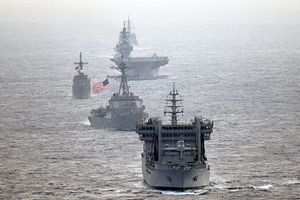From May 2 to May 8, six warships from four like-minded Indo-Pacific states conducted a range of low-key maritime activities in the South China Sea. Vessels with the United States Navy, the Japan Maritime Self-Defense Force, the Philippines Navy, and the Indian Navy sailed together for the first time in the area demonstrating presence and cooperation.
The vessels were in transit in the aftermath of the ASEAN-Plus Defense Ministers’ Meeting Maritime Security Field Training Exercise 2019 in Busan, South Korea. The Indian vessels, meanwhile, had been on a longer deployment, where they had participated first in a bilateral exercise with the Vietnamese Navy and then attended the Chinese People’s Liberation Army Navy’s fleet review to commemorate the 70th anniversary of its founding.
These exercises have rightly received attention as a sign of growing cooperation among Indo-Pacific states. Indeed, these kinds of activities should serve as a model of the kinds of cooperation Indo-Pacific navies should be undertaking in the future.
What stood out about the transit was the low profile of the activities undertaken in international waters in the South China Sea. The vessels “conducted formation exercises, communication drills, passenger transfers and held a leadership exchange,” according to a U.S. 7th Fleet statement. None of these activities was particularly provocative, but it demonstrated cooperation and growing interoperability between these countries.
In doing so, the four countries underscored their joint presence in the disputed waters of the South China Sea. Despite the July 2016 ruling by the Hague-based arbitral tribunal finding, among other things, that China’s so-called nine-dash line claim was invalid under international law, Beijing continues to claim nearly the entirety of the South China Sea.
These kinds of operations should become increasingly regularized and provide an important signal that is complementary to more forward-leaning activities in and around the South China Sea. In recent years, these have included U.S. and allied freedom of navigation operations, which China has painted as evidence of “militarization” in the South China Sea, in addition to more ambitious bilateral exercises that explore mission sets such as anti-submarine warfare.
A simple multilateral set of drills, in the meantime, including formation exercises, passing exercises, communications drills, and crew and leadership exchanges can serve to underscore regional solidarity in favor of a free and open Indo-Pacific in an important way. It will remain to be seen if the circumstances that allowed for this impromptu quadrilateral engagement in the South China Sea can be recreated soon.
For advocates of the so-called “Quad” comprising the United States, Japan, Australia, and India, a big-ticket quadrilateral exercise has long been a priority. But there are options for these countries short of a major, coordinated set of exercises. Simply demonstrating presence together can go a long way in underscoring the principles that should underlie a free and open Indo-Pacific.

































